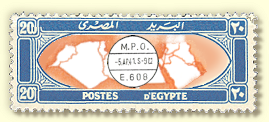

 The various named MPOs, i.e M.P.O. ABU-QIR, in use prior to the war were changed to numbers in the 600 series in 1939 (E. 601 to E. 615). These were introduced by the desire to obscure the origin of the letter for security reasons. The datestamps were produced locally in Egypt. E602 was inscribed BPO (Base PO) (two stamps) or MPO (Military PO) (one stamp). E601 had five easily distinguished stamps inscribed MPO, and MPO was also used for E603, E604, E607 and E608 The other numbers used were designated FPO (Field Post Office - potentially mobile). The earliest recorded use is on 1st October 1939. These post offices were not staffed by Royal Engineers (Postal Section) personnel, but by soldiers drawn from units stationed in Egypt, presumably some at least with postal experience in civilian life. The service was run in September 1940 by Lieut Cox. A senior British postal officer, Assistant Director of Army Postal Services Lt Col R E Evans arrived in Cairo from England on 20th July 1940, followed on 23rd August by postal units including 5 Line of Communications P U and “B” Divisional P U. Personnel of these units were soon attached to the existing military post offices 5 L of C P U. The static offices and “B” Div P U. The Royal Engineers Postal Service formally took over the postal service, redesignating the offices with standard nomenclature of the period: “S” for stationary APO, and “H”, “D” or simple number, each in conjunction with letter “E” for Egypt, for respectively Corps, Division or Brigade or equivalent FPO. Each office was issued with a standard double ring FIELD POST OFFICE datestamp. The field offices in the Western Desert to gradually transform them into full field post offices, and some additional offices were opened On 24 September 1940 The theoretically the numbered ‘E’ series of datestamps became obsolete on 24th September 1940 with the possible exception of E610 which apparently continued in use for some months and were then held in store. However they came in useful to make up for a shortage of Australian and Indian datestamps, and to a lesser extent British ones. MPO ABU SUEIR, serving RAF units, was not replaced by a numbered MPO datestamp or FPO, and continued in use at least until at least 7th October 1940. Occasional usage of MPO CAIRO continued into 1940. Some E offices were opened as detachments of Indian offices in the Western Desert. A few Royal Engineers Postal Service offices opened shortly before the official takeover date, but it is not known what datestamps were used at these prior to 24th September With the build up of troops from India and Australia, without sufficient handstamps of their own, in the first part of 1941 Some E Series date-stamps were transferred to Indian or Australian FPOs. During most of 1940 letters were franked with the 10m. ARMY POST stamps almost exclusively that of King Fouad These were gradually replaced by Indian or Australian FPO and most E Series date satmps had ceased to be used after 1941, but with a few exceptions.
|
|
|